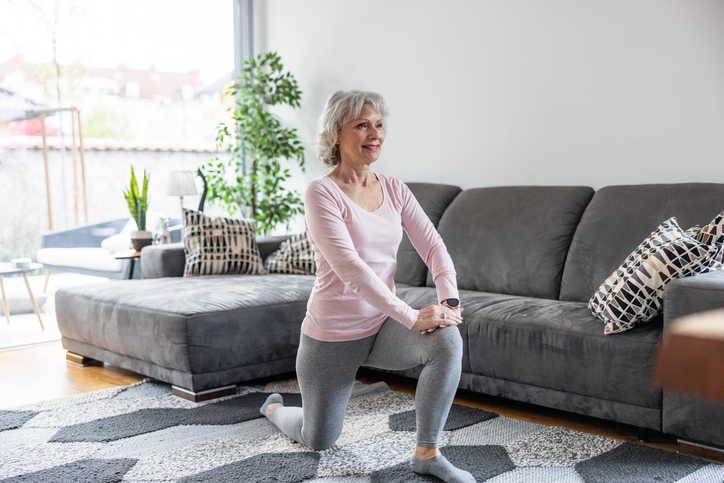For many older adults, knee pain and stiffness make simple movements feel like obstacles. Fortunately, there are steps you can take to keep your knees strong and healthy. Maintaining knee health is your ticket to preserving your independence, mobility, and freedom to enjoy life to the fullest.
Understanding how to care for your joints can help you continue participating in the activities you love. In this guide, we will explore common factors that impact knee health and practical steps you can take to strengthen your knees and reduce pain.
Please note this article is not medical advice. Before starting any new diet or exercise routine, consult your doctor or a qualified healthcare professional to determine the best approach for your needs.
What Impacts Your Knee and Joint Health As You Age?
Dr. Mason Harris of the Conde Center for Comprehensive Spine and Wellness explains that gravity uniquely affects the human body. Because we walk upright, we are more prone to joint, back, and neck issues. Although aging can bring about natural changes to your joints, understanding these shifts can help you take proactive steps toward maintaining healthy knee function.
Cartilage Breakdown
Cartilage is the smooth, flexible tissue that cushions your joints, allowing pain-free movement. Over time, cartilage naturally wears down due to repetitive use, leading to stiffness and discomfort. As cartilage thins, bones may rub together, causing inflammation and joint pain, a common symptom of osteoarthritis. Supporting cartilage health through movement and nutrition can help slow this process.
Muscle Loss (Sarcopenia)
Muscle mass naturally declines with age, reducing stability around the knee joint. Strong quadriceps and hamstrings act as shock absorbers, minimizing knee strain. When these muscles weaken, your joints take on extra pressure, leading to pain and increased fall risk. Strength training and a protein-rich diet can help preserve muscle strength and protect knee health.
Decreased Bone Density
After age 50, bone mineral density declines, increasing the risk of fractures and joint instability. Osteoporosis can weaken bones, placing additional stress on the knee joint. Weight-bearing exercises and adequate calcium and vitamin D intake help support strong bones and healthy movement.
Loss of Flexibility
Ligaments and tendons lose elasticity with age, limiting knee mobility and increasing the risk of injury. Tight hamstrings, stiff quadriceps, and inflexible calf muscles can contribute to joint strain. Incorporating gentle stretching into your daily routine can improve flexibility and reduce discomfort.
Other Factors
In addition to natural aging, factors such as arthritis, past injuries, genetics, and occupational strain can affect knee health. If you have a history of joint pain or inflammation, lifestyle adjustments and proper medical guidance can help minimize discomfort. If knee pain is persistent, a professional evaluation can help determine the root cause.
“Everybody’s body tells a story,” Dr. Harris says. “Getting a baseline from a good diagnostician, whether it be a physical therapist, a chiropractor, a massage therapist, a trainer, and knowing where to start is the hardest part.”
How to Keep Your Knees Healthy: 3 Tips for a Holistic Approach
Caring for your knees requires a combination of proper nutrition, targeted exercises, and overall wellness. By prioritizing joint-friendly habits, you can continue enjoying an active lifestyle.
Before starting any new diet or exercise program, consult your doctor or a qualified healthcare professional.
1. Prioritize Joint-Healthy Foods
Nutrition plays a vital role in reducing inflammation and supporting joint health. A well-balanced diet can help maintain mobility and prevent further joint deterioration. Consider adding the following foods:
- Omega-3-rich foods – Salmon, flaxseeds, and walnuts help combat inflammation.
- Antioxidant-rich fruits and vegetables – Berries, spinach, and kale support collagen production.
- Vitamin C and D sources – Citrus fruits and fortified dairy aid in cartilage repair.
- Calcium and vitamin K – Found in leafy greens and dairy, these nutrients promote bone strength.
- Stay hydrated – Water makes up a significant portion of joint cartilage, keeping it supple.
- Limit processed foods – Sugary drinks, excessive red meat, and highly processed foods contribute to inflammation.
2. Build Up Strength with Knee Exercises for Seniors
Regular exercise plays a crucial role in maintaining knee strength, stability, and overall joint health. Strengthening the muscles around your knees provides added support, reducing strain and minimizing pain. Engaging in the right exercises can improve mobility, enhance balance, and decrease the risk of falls.
Seated Knee Exercises
For seniors with limited mobility, seated exercises offer a safe and effective way to strengthen knee-supporting muscles. These exercises help improve stability and flexibility without excessive strain on the joints.
- Straight Leg Raises – Sit in a sturdy chair, extend one leg straight out, hold for five seconds, then lower it slowly. Repeat 10-15 times per leg.
- Knee Extensions – While seated, slowly extend your leg until it is straight, then lower it back down. Perform 10-15 repetitions per leg.
- Heel Slides – Sit comfortably and slide one heel back toward your chair, bending your knee. Hold for a few seconds before returning to the starting position. Repeat 10 times per leg.
Knee Stretching
Flexibility is key to maintaining joint health and preventing stiffness. Gentle stretching exercises can improve range of motion and reduce tension around the knees.
- Hamstring Stretches – Sit on the edge of a chair, extend one leg straight, and lean forward gently until you feel a stretch in the back of your thigh. Hold for 20-30 seconds per leg.
- Calf Stretches – Stand facing a wall, step one foot back, and press your heel into the floor while keeping the back leg straight. Hold for 20-30 seconds before switching sides.
- Quadriceps Stretches – Holding onto a chair for support, gently pull one ankle toward your glutes to stretch the front of the thigh. Hold for 20-30 seconds per leg.
Exercises for Knee Stability
Improving knee stability enhances balance and reduces the risk of falls. These exercises strengthen the muscles responsible for joint support.
- Wall Slides – Stand with your back against a wall, slowly slide down into a partial squat, then return to standing. Perform 10 repetitions.
- Chair Squats (Modified) – Lower yourself into a seated position from a standing position, then rise back up using your leg strength. Repeat 10-15 times.
- Heel Raises – Holding onto a chair for support, rise onto your toes, then slowly lower back down. Perform 10-15 repetitions.
Incorporating these exercises into your daily routine can promote stronger, healthier knees. Always listen to your body and modify movements as needed.
“We want to do load-bearing exercises,” says Dr. Harris. “That doesn't mean jumping jacks for hours. It means body weight supported (activities). Start with your body weight.”
3. Support Overall Wellness with Knee-Friendly Cardio
Low-impact cardiovascular exercise promotes circulation, manages weight, and strengthens muscles. Gentle activities on the joints prevent further strain while keeping you active and mobile. Finding an exercise routine you enjoy and can sustain over time is key to long-term knee health.
“Try to find something that you enjoy,” says Dr. Harris. “You know, if you don't like cardio, I don't like cardio that much either. I don't run unless I'm running from something. [Find] something you enjoy and then try to expand from there.”
Walking for Knee Health
A daily walk keeps joints flexible and reduces stiffness. Start with short distances and increase gradually. Use supportive footwear and choose even surfaces to minimize strain. Walking with a friend or in a scenic environment can make the experience more enjoyable and keep you motivated.
Pool Exercises for Knee Health
Water workouts reduce joint pressure, making movement easier. Walking in water, leg swings, and aqua aerobics are excellent low-impact options. The buoyancy of water supports the body, reducing strain on the knees while still providing effective resistance for muscle strengthening. Many senior-friendly aquatic classes also offer social engagement, making exercise both enjoyable and beneficial.
Explore Wellness & Rehabilitation Services at Friendship Village of Bloomington
At Friendship Village of Bloomington, we believe in supporting your well-being through personalized wellness programs and an active social community. From yoga classes to heated pools, and scenic walking trails to expert-led rehabilitation services, our community is designed to help you move with confidence.
Your journey to better joint health starts here. Contact us today to schedule a tour and explore all the ways Friendship Village of Bloomington can help you stay active and independent.


